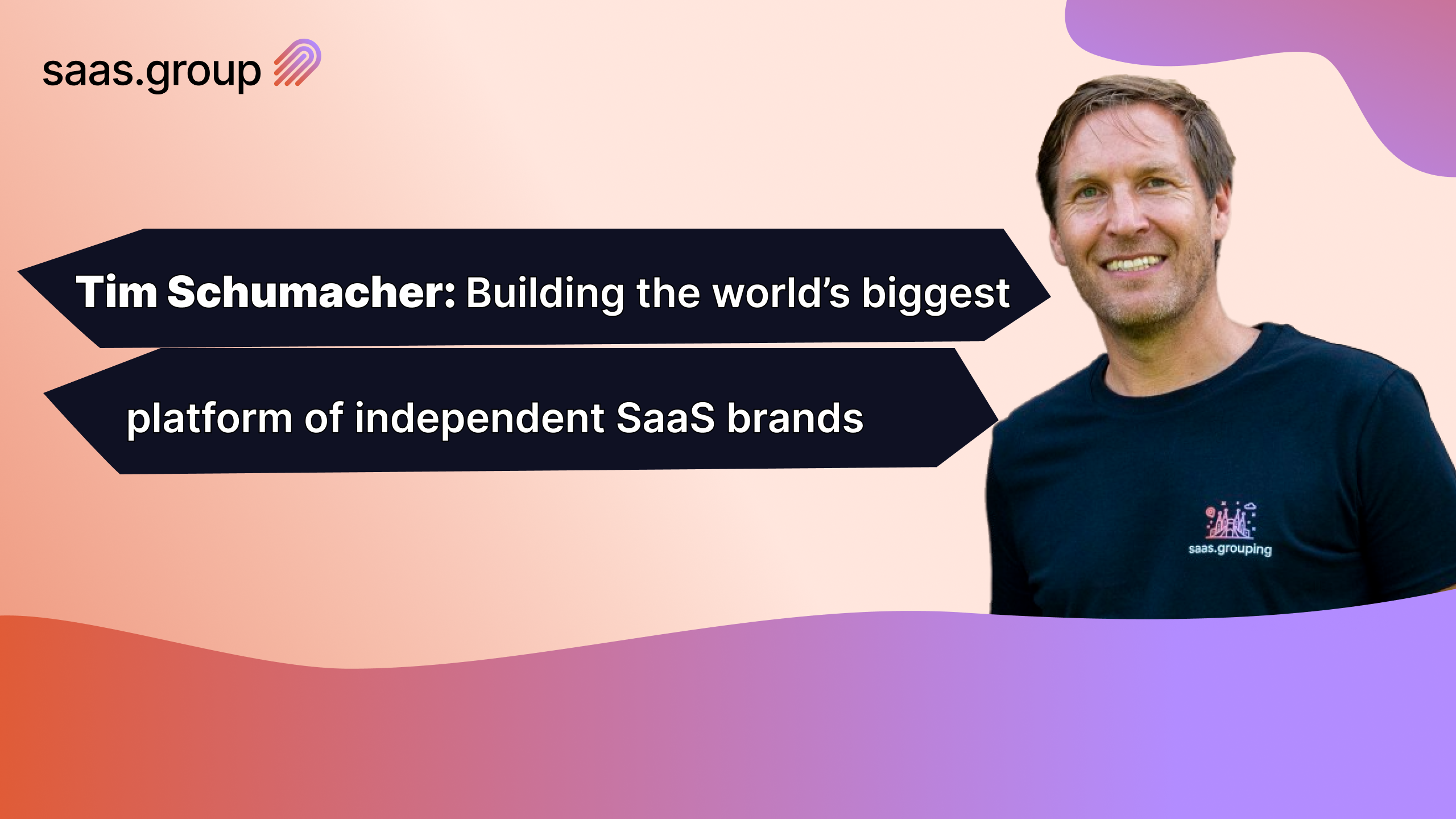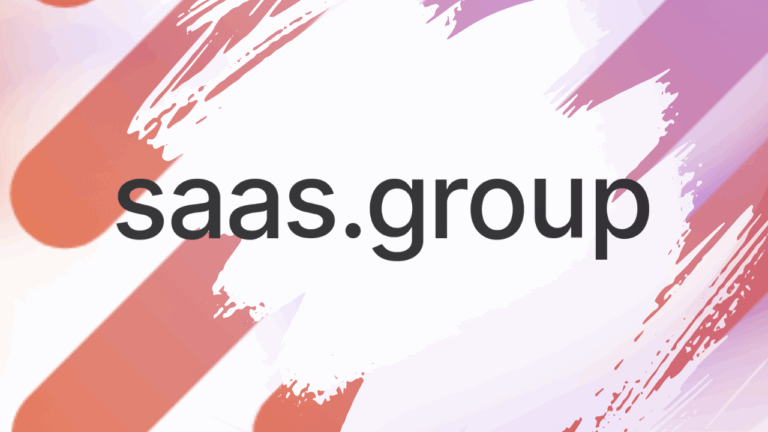After the vision for saas.group had been announced, we sat down with Tim Schumacher to talk about it more in depth. Before we dive in, we’ll highlight the emphasis on shared values and a founder-friendly ethos in acquisitions. He strives to balance autonomy with deeply entrusted partnership and preserve the “bootstrapper mentality” in teams.
– We’ve recently announced the long-term vision for saas.group to become the biggest platform of independent SaaS brands worldwide. How did we get here? Let’s dig into your background a little bit and see how saas.group was born.
Sure. I’ve been an entrepreneur all my life. I started coding as a teenager and founded a company called Sedo.com, a domain marketplace, which I ran for 10 years. Fast-forward to 2012, and I became an angel investor, and also started a few other companies that I was the founder of, but had someone else run them.
At some point, I realized that I was far better at scaling things than building something new. By that time, I was also approached by talented founders who were the exact opposite of that. They were builders, and operating bigger ventures was not something they enjoyed.
So, I put two and two together and decided that acquiring these businesses and taking them to the next level would be an excellent idea. At that point, I had seen many acquisitions go horribly wrong, because the acquirers didn’t understand how to operate the acquired businesses. I knew exactly what I wanted to change.
It all started with DeployBot, saas.group’s very first acquisition, and before we knew it, we grew to 18 brands and over 200 people in 30 countries. This is just the beginning of that journey.
– Why do you think culture is an important factor in the possible acquisition?
When we look at the founders we talk to and their projects, we look at a lot of factors. First, from a quite superficial customer perspective, and then during the due diligence, we get deeper into how things are coded, the quality of the tech stack, and culture, too.
We generally just try to work with founders who have a positive culture, and who run the company the way we think it should be run. It’s then just so much easier to integrate.
After the DeployBot acquisition, we started to look into similar projects with small teams that were bootstrapped and very hands-on. Now, we tend to acquire bigger companies that have raised some funding before. But we’re still after the bootstrapper mindset where teams are frugal, revenue-focused, and down to earth.
To us, we think that it’s a great DNA for running a company. It all boils down to the fact that it’s much easier to acquire something that is similar in terms of values and culture.
– So it’s a founder-friendly, and also a team-friendly approach? A lot of teams are confused about what happens to them after the acquisition. What is the case at saas.group?
Yes, we’re striving for the power of the team. I think Amazon’s Jeff Bezos once coined the two-pizza rule; that the most effective teams are actually small teams. I’ve seen so many teams balloon to 50 or 100 people, and they’re often less productive than high-performance teams of 10 people. That’s why I want to keep responsibility within teams.
We believe that because most of the projects are niche projects, they are also better run somewhat independently. Having said that, we have central teams for marketing, DevOps, HR, and finance that are ready to jump in to offer their expertise and get the product to a certain standard if there’s a need for that.
The founder-friendly approach is also extremely important for us, and the one question that I always start my meetings with is “Why are you selling?”. And I want to hear an honest answer.
Depending on the answer, we can adjust our offer and the terms of the deal. If a founder is burned out and wants to cash out and leave, it wouldn’t make sense to ask them to have a 3-year earn out period. This would be the worst-case scenario for everyone involved. That’s why we’re pushing for the “dream exit” narrative. We think that after all the sweat and tears founders put into their products, they deserve to get the conditions that work for them.
– How is saas.group’s approach different from other PE companies acquiring SaaS businesses?
In the very classic PE (‘private equity’) model, you usually have bigger companies. They are acquired purely on a financial basis, and I honestly think most PEs usually don’t know how to run a product. They look at it from a financial standpoint only.
Also, the scale where we operate is usually pretty small for PE companies. Most of them start at $10M annual recurring revenue. The reason we chose this model is that this niche is underserved. A lot of founders build great niche products with a few million in revenue, but nobody is lining up to acquire them because they seem too small for traditional PEs.
Our range is usually between $2M and $5M, but we also look into smaller companies that are growing fast (and sometimes also at bigger ones). With our shared central services model and a lot of independence for the teams, we feel we’re just the perfect fit for this size of company and for delivering real value to founders who otherwise would be otherwise handcuffed to their businesses.
We’ve talked to many successful founders, and we’ve seen businesses that often make a million dollars in annual recurring revenue, yet they cannot take a single day of vacation, because they are also the customer service person, and that could feel like prison over time.
I admire their dedication for that, but it can be a hamster wheel that we can help them get out of and into a much better setting. Even if they decide to stay with the company after the acquisition.
– What is important to understand about a business and the founder when they come to you about a possible acquisition?
I want to hear why the founder wants to sell and not what the broker says. While brokers can be very helpful in preparing information and structuring a deal, they tend to have their standard phrases on why the seller wants to sell.
I want to hear the real personal story because that’s the only way we can tailor an offer and tailor a way forward to the founder’s personal life circumstances. That’s really important because only then can it work. If we tell the founder, “hey, you’ll have a three-year earn-out”, and the founder wants to leave within the next three months because of burnout, it’s not going to work.
Either way, we are fine working with both scenarios: the founders who want to leave within three months, and the founders who want to stay with us and focus on a different role, or even the same role, just with a bit more financial security. Both are fine. We can work with either.
– What is the biggest challenge of acquiring companies?
There are a lot of challenges, even before we get companies on board, from finding the right people to actually negotiating a price. Very often, the price expectation is the single biggest problem. Founders read of Figma being acquired for $20B by Adobe, and they started comparing the numbers and saw that it’s about 40x multiple on revenue and set wrong expectations for their own potential deals.
Then there’s the due diligence for tech, marketing, HR, as well as legal and financial. After we sign a letter of intent, which is usually unbinding but signed by both sides. We view it as a handshake agreement and start figuring out the rest of the data and negotiate things from there.
For us, this means we’re going forward with the deal, and unless we find skeletons in your closet that fundamentally change things, we are absolutely committed to honor that deal.
So preparation and transparency are very important in the early stages of the deal. Over the acquisition process, we learn a lot about the company, the good, the bad, and the crazy. And we want to be able to have an honest conversation about the things we could potentially change moving forward. We don’t want to have a business and then hit the founder with a surprise.
– How is it going with the integration of all the people inside? How do you make sure that everyone feels like a member of saas.group family, coming from different companies/cultures/work settings?
I think we try to keep a fine balance between the independence of the team and the feeling of belonging with joint communication channels.
It starts with things like Slack and having common databases, to going to an annual retreat together. Our saas.grouping is a retreat where we bring everyone together for a few days to get to know each other, have a good time, and, of course, learn a bit about the company.
We also have a lot of digital formats, being a remote company. Starting with saas.unbound podcast, then saas.academy for our own internal knowledge-sharing sessions, and then, the most important thing, is actually working together.
– Over the 5 years that saas.group has been around, you’ve moved on from buying only bootstrapped companies to those that have raised some funds in the past. The only requirement that is standing is the “bootstrapper mindset”. What do you mean by that, exactly?
We bought several of these companies (Zenloop and Beekast, to name a couple), and after reflecting on what we liked and didn’t like, we realized that it’s not about the funding model but more about the mentality of the founders.
Bootstrapped founders have immense pride in taking ownership and accountability for their products. As the ultimate decision-makers, they thrive under resource constraints, championing efficiency, and a hustle mindset to achieve results.
To add to that, running a bootstrapped company also demands more focus on essential Key Performance Indicators (KPIs). When we start working with brands, we focus on that. It might sound boring, but at the same time, having a clear idea of your goals and success measurements gives us a much better perspective on missed opportunities.
Monetization is another important aspect we look for. Even with funding, it’s all about wise capital allocation. We like to work with founders who treat capital as a scarce resource and use it accordingly. For example, actively finding ways to reduce costs, buying software instead of building it, and being cautious with pricing and other offerings. Remote work setups are also one of the things we find very effective in reducing the cost of operating a business – in addition to the flexibility, diversity, and productivity they bring.
– What are your favorite stories/ideas that a brand executed after being acquired by saas.group?
I think one of my personal favorite stories is the one of Prerender moving off the AWS and cutting their server cost 80%. This is the true bootstrapper mindset in action, and exactly what we’re looking for at saas.group. Since we keep the brands independent, they are encouraged to take action and be responsible for their own decisions. This entrepreneurial approach now saves Prerender.com $800k per year and proved to be a very smart move for them.
Another story that I really like is from MyWorks Software. And Peter Leonard, their founder, in particular. When he came to us to have MyWorks acquired, all he wanted was a way out. He was missing important family holidays, had a newborn, and wanted to have more time with his loved ones. During the due diligence process, we could identify a different way to go, offering Peter a position where he’d be doing something he loves, still executing on his vision but having way more freedom and less financial risks. We’re very happy to have him on board with us for over a year now and going strong.
– What is the hack that you could share with the founders that could help them if they want to get acquired? What is something that usually works in initiating the first calls, building goodwill, or even making sure that the asking price is something very reasonable and actually achievable?
I wouldn’t say there’s this one hack like this brilliant hack. Like with everything else In businesses, you do a decent preparation. So, for example, a lot of founders approach the process unprepared. I think it’s good to just have your basic numbers ready, to have them somewhat sorted, just that there’s a good appearance of your overall business, and then just do a few conversations without immediately offering the business for sale.
Educate yourself, have a few conversations with potential inquirers to find out what they want, and have an open conversation. Work on having a “product-market fit” for the acquisition because that’s also important. If the product, in this case the company, doesn’t fit the market, the acquirers, then there’s no deal. But it’s a learning opportunity.
So, one hack would be to just approach it as you would approach product market fit, talk to a few people before you make your offering, and then actually go to market instead of going to some broker and letting that person figure everything out because that usually doesn’t work.
If our values speak to you and resonate with how you do business, get in touch. Discuss your options with our M&A team: Dirk ([email protected]) or Pavel ([email protected]). Learn more about how we grow acquired brands on our blog and podcast pages.
Table of Contents
Weekly newsletter
No spam. Just the latest news and articles from the world of SaaS and Acquisitions.




